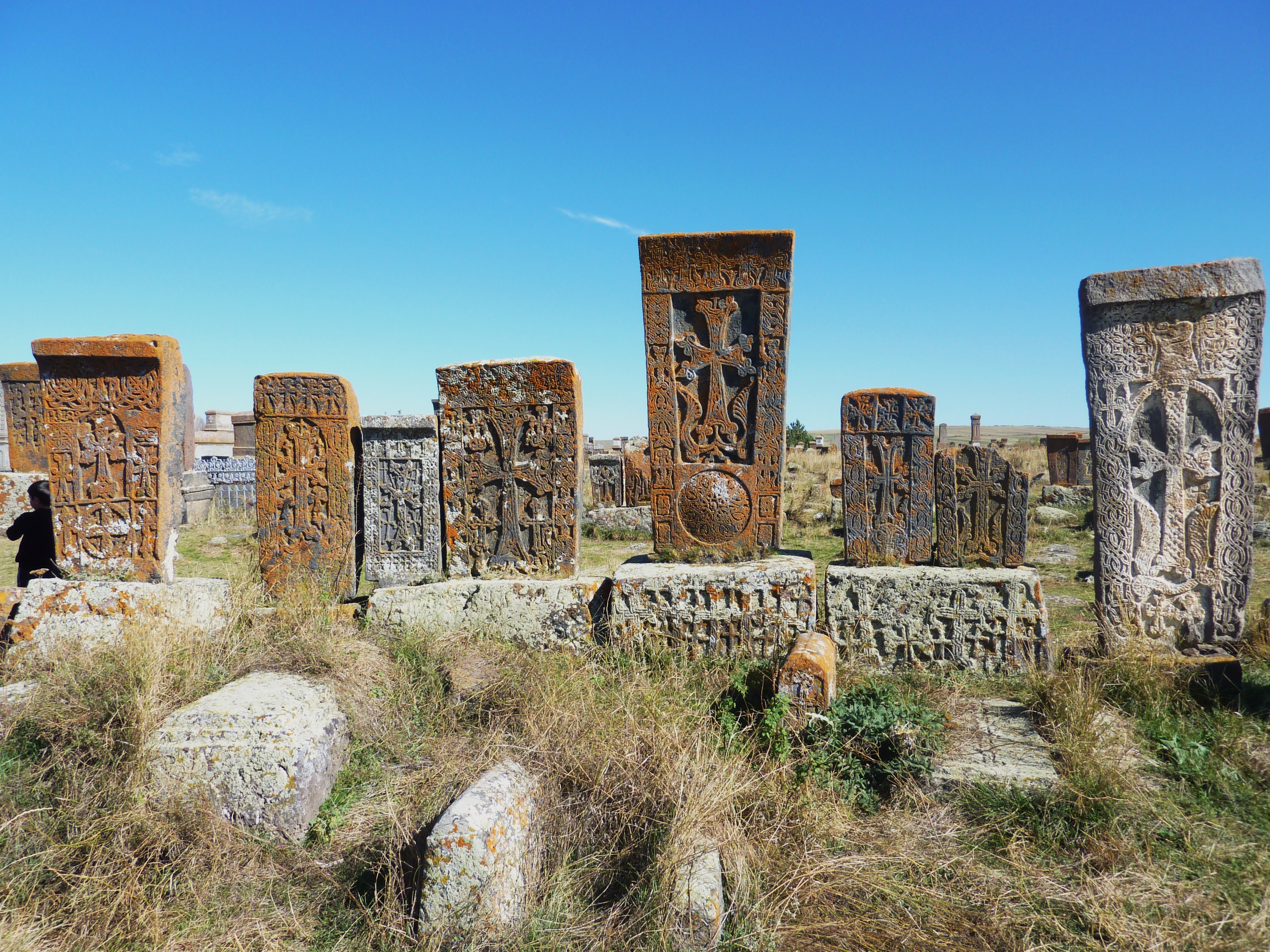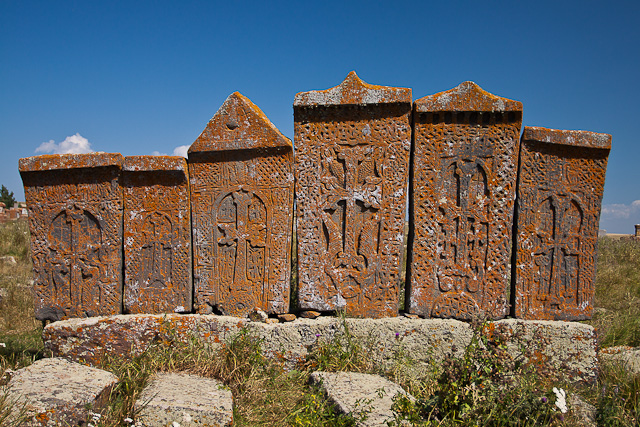Noratus cemetery on:
[Wikipedia]
[Google]
[Amazon]
Noratus cemetery, also spelled Noraduz, ( hy, Նորատուսի գերեզմանատուն) is a medieval cemetery with many early
 The oldest khachkars in the cemetery date back to the late 10th century. During the revival of the khachkar tradition in the 16-17th centuries many khachkars were built under the yoke of the
The oldest khachkars in the cemetery date back to the late 10th century. During the revival of the khachkar tradition in the 16-17th centuries many khachkars were built under the yoke of the British Museum Collection
/ref> The front face of the rectangular khachkar has a leaved-cross with two smaller crosses below that are framed with
 A popular folktale associated with the cemetery concerns the invading army of
A popular folktale associated with the cemetery concerns the invading army of
File:Noraduz cemetery 2.jpg, Tombstone depicting a wedding celebration.
Image:Noraduz chapel.jpg, Chapel at the cemetery.
Image:Noratus Khachkars.jpg, Khachkars and a tomb.
File:Noratus Khachkar.jpg, Khachkars
File:Noratus Strzygowski.png, in the early 20th century
khachkar
A ''khachkar'', also known as a ''khatchkar'' or Armenian cross-stone ( hy, խաչքար, , խաչ xačʿ "cross" + քար kʿar "stone") is a carved, memorial stele bearing a cross, and often with additional motifs such as rosettes, in ...
s located in the village of Noratus
Noratus ( hy, Նորատուս; also known as ''Noraduz'') is a village in the Gegharkunik Province of Armenia, near the town of Gavar
Gavar ( hy, Գավառ) is a town and urban municipal community in Armenia serving as the administrative ce ...
, Gegharkunik Province
Gegharkunik ( hy, Գեղարքունիք, ) is a province ('' marz'') of Armenia. Its capital and largest city is Gavar.
Gegharkunik Province is located at the eastern part of Armenia, bordering Azerbaijan. It includes the exclave of Artsvas ...
near Gavar
Gavar ( hy, Գավառ) is a town and urban municipal community in Armenia serving as the administrative centre of Gegharkunik Province. It is situated among the high mountains of Gegham range to the west of Lake Sevan, with an average height ...
and Lake Sevan
Lake Sevan ( hy, Սևանա լիճ, Sevana lich) is the largest body of water in both Armenia and the Caucasus region. It is one of the largest freshwater high-altitude (alpine) lakes in Eurasia. The lake is situated in Gegharkunik Province, ...
, 90 km north of Yerevan
Yerevan ( , , hy, Երևան , sometimes spelled Erevan) is the capital and largest city of Armenia and one of the world's oldest continuously inhabited cities. Situated along the Hrazdan River, Yerevan is the administrative, cultural, and i ...
.
The cemetery has the largest cluster of khachkars in Armenia. It is currently the largest surviving cemetery with khachkars following the destruction of the khachkars in Old Julfa, Nakhichevan by the government of Azerbaijan
Azerbaijan (, ; az, Azərbaycan ), officially the Republic of Azerbaijan, , also sometimes officially called the Azerbaijan Republic is a transcontinental country located at the boundary of Eastern Europe and Western Asia. It is a part of th ...
.
Khachkars
Safavid Empire
Safavid Iran or Safavid Persia (), also referred to as the Safavid Empire, '. was one of the greatest Iranian empires after the 7th-century Muslim conquest of Persia, which was ruled from 1501 to 1736 by the Safavid dynasty. It is often conside ...
when oriental influences seeped into Armenian art. Three master carvers from this period carved khachkars in Noraduz, the most notable of whom was Kiram Kazmogh (1551-1610), his contemporaries were Arakel and Meliset. The cemetery is spread over a seven hectare field containing almost a thousand khachkars each of them depicting unique ornamentation. The majority of the khachkars are covered by moss
Mosses are small, non-vascular flowerless plants in the taxonomic division Bryophyta (, ) '' sensu stricto''. Bryophyta ('' sensu lato'', Schimp. 1879) may also refer to the parent group bryophytes, which comprise liverworts, mosses, and ...
and lichen
A lichen ( , ) is a composite organism that arises from algae or cyanobacteria living among filaments of multiple fungi species in a mutualistic relationship.British Museum
The British Museum is a public museum dedicated to human history, art and culture located in the Bloomsbury area of London. Its permanent collection of eight million works is among the largest and most comprehensive in existence. It docum ...
in 1977 by Catholicos
Catholicos, plural Catholicoi, is a title used for the head of certain churches in some Eastern Christian traditions. The title implies autocephaly and in some cases it is the title of the head of an autonomous church. The word comes from ancient ...
Vazgen I
Vazgen I also Vazken I of Bucharest, (), born Levon Garabed Baljian ( hy, Լևոն Կարապետ Աբրահամի Պալճյան; September 20, 1908 – August 18, 1994) was the Catholicos of All Armenians between 1955 and 1994, for a total of 3 ...
.*/ref> The front face of the rectangular khachkar has a leaved-cross with two smaller crosses below that are framed with
trefoil
A trefoil () is a graphic form composed of the outline of three overlapping rings, used in architecture and Christian symbolism, among other areas. The term is also applied to other symbols with a threefold shape. A similar shape with four ring ...
and bunches of grapes projecting from either side. An inscription on the left side seeks God's mercy for a certain Aputayli.
Folklore
 A popular folktale associated with the cemetery concerns the invading army of
A popular folktale associated with the cemetery concerns the invading army of Tamerlane
Timur ; chg, ''Aqsaq Temür'', 'Timur the Lame') or as ''Sahib-i-Qiran'' ( 'Lord of the Auspicious Conjunction'), his epithet. ( chg, ''Temür'', 'Iron'; 9 April 133617–19 February 1405), later Timūr Gurkānī ( chg, ''Temür Kür ...
. According to one story the villagers placed helmets on top of the khachkars and leaned swords against them. From a distance the khachkars looked like armed soldiers holding a defensive position as a result of which Tamerlane's army retreated.
In another popular story, the 19th-century monk named Ter Karapet Hovhanesi-Hovakimyan, from a monastery near the village, conducted burial services at Noraduz; in order to avoid the two-hour round trip from the cemetery to the monastery he built himself a small cell in Noraduz. When he was 90 years old, he asked his brother monks to bury him alive. His last words were: "I do not fear death. I would like you to not be afraid also. Never fear anything, but God alone. Let anyone who has fear come to me. Pour water at the burial stone, drink the water, wash your face, chest, arms and legs. Then break the vessel that contained the water. Fear will then abandon you." To this day people come to the monk's grave to perform this ritual, leaving broken pieces of glass scattered all about.
Gallery
References
Further reading
* * {{coord, 40, 22, 26, N, 45, 10, 52, E, region:AZ_type:landmark_source:kolossus-frwiki, display=title Armenian cemeteries Cemeteries in Armenia Eastern Orthodox cemeteries Tourist attractions in Gegharkunik Province 10th century in Armenia Buildings and structures in Gegharkunik Province